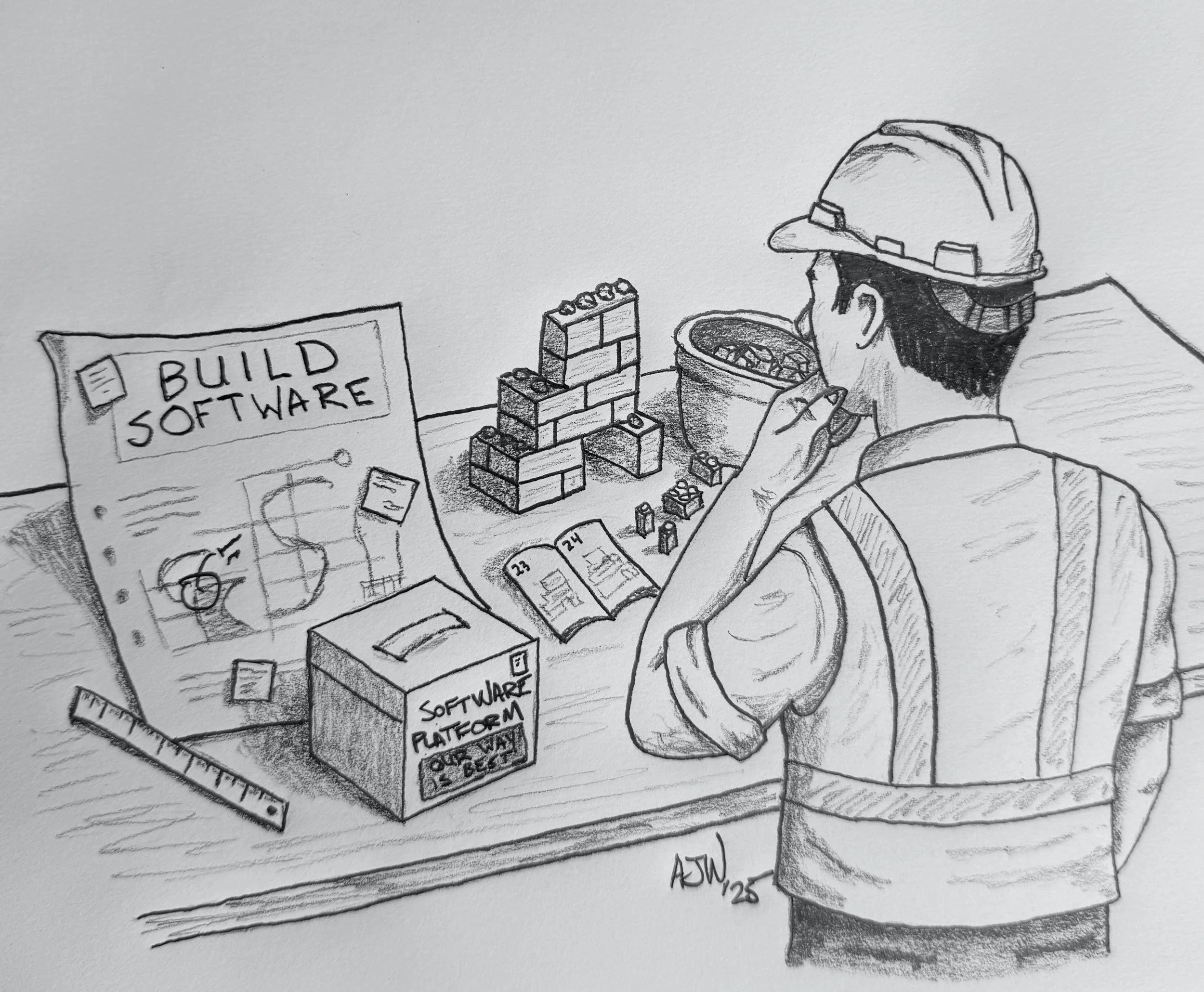In the Great Tech Debate of Build vs Buy…Is It Too Much to Ask for Both?
In a world that’s ripe with questions surrounding the buzziest of buzzwords, like “Should we use AI?” or “Will robots replace field crews?” there is a totally different topic that still reigns supreme. The real question, the one that’s been keeping IT leads, ops managers and even CEOs up at night is simpler, but somehow way messier:
Do we build our own construction software OR do we buy something off the shelf?
This question has sparked more internal arguments than the question of Die Hard as a Christmas movie (which it is) and everyone seems to have a strong opinion; certain the other side is dead wrong.
I have lived both sides and seen the pros and cons from every angle. But as the late, great Tony Stark once put it…“Is it too much to ask for both?”
Let me explain.
The Argument for Build: A System That Actually Works
Let’s start by taking it back to my roots, where once upon a time we built a system from scratch to meet our needs. Trust me, we tried to run our jobs on commercial software but quickly found it didn’t speak construction fluently. Back charges? Eh. Production factors? What’s that?
So, instead we went the MacGyver route and said: “Forget it. We’ll build it ourselves.”
Why?
Control. You want it to do something? You build it. Now. No tickets. No waiting for a vendor to approve it on the next roadmap.
Customization. Your processes are your secret sauce. Why dumb them down just to fit into someone else’s system?
Agility. Missed a step in the workflow? Add it. Want to automate a new process? Code it. Done.
Ownership. Your data, your logic, your system. It is all yours to evolve.
And let’s be real: off-the-shelf software often claims it’s “intuitive,” but what it really means is “you’ll figure it out eventually while yelling at your laptop.”
So, to us building sounded great…until it didn’t.
The Argument for Buy: Plug, Play and Prosper
After a few years of custom development, I became one of those folks wearing the vendor badges and living in the cloud. Enter Team Buy. The case is definitely compelling: why reinvent the wheel when someone already built you a Ferrari?
Buying commercial construction software off the shelf comes with some serious perks:
Speed to deploy. No coding, no drama. Turn it on and go.
Battle-tested features. The best vendors have refined their software based on feedback from thousands of users (aka: they learned from other people’s mistakes).
Training and support. You don’t have to write a user manual. Heck, you don’t even have to explain what a change order is. The vendor’s already done that.
Security and scalability. These tools are hardened, certified and can handle more project complexity than your last five RFPs combined.
And if you’re a team that builds schools or bridges (not software), off-the-shelf tools let you focus on construction and not debugging your own codebase in the middle of a bid deadline.
They all seem like fair points, right?
Well…
The Problem with Both Camps
At the end of the day, both sides are right. But both are also incredibly annoying.
Buying gives you a solid foundation. Think of it like the old glue-together model kits you built as a kid. Looks great when done, but what you see is what you get. Good luck when you need a new feature from a vendor hasn’t prioritized change since 2017. You submit a ticket… and wait. And wait. And then hear, “That’s not currently on our roadmap.”
Cool. Glad I’m not on your roadmap either.
Building gives you total freedom. More like 3D printing the model kit from scratch. But freedom comes with strings. Long, tangled strings of mismatched parts, QA cycles, re-training users every time something changes and the never-ending “Are we done yet?” from your PM.
But the worst part? Both sides make assumptions that don’t hold up in the field:
Buy assumes everyone works the same. They don’t. Every contractor, owner and program manager has a twist on “how we do it.”
Build assumes you’ll always have the time and talent to keep evolving. You won’t. Developers leave. Priorities shift. Code gets stale.
And all the while, projects roll on. The field needs answers. The office needs data. And your tech stack? It’s fighting a war of attrition.
Enter the Plot Twist: The Argument for Both
What if I told you there’s a third option? One that gives you the speed of buying and the flexibility of building…without the headaches of either?
Say hello to Platform as a Service.
PaaS isn’t just another acronym. In a world full of “game-changers”, it really is one.
Now, instead model glue and 3D printers, you have a Lego kit. Instructions out of the box for exactly what you would expect, but the building blocks to mold it into whatever you can imagine. You start with a commercial-grade, off-the-shelf platform that handles the heavy lifting you would expect (think hosting, security, compliance, core features, all of it). But layered on top of that is a low-code toolkit that lets you configure, extend and even build your own applications within the platform.
Translation: You get the best of both worlds.
Enabling Your Uniqueness Without Chaos
When push comes to shove, most construction companies have about 80% of their processes in common: budgets, RFIs, change orders, daily reports, it’s all pretty similar. That’s where off-the-shelf platforms shine. They’re fast to deploy and loaded with industry best practices.
But that other 20% or so? That’s your edge. That’s where your firm stands out.
And that’s where PaaS comes in.
With PaaS, you can:
Start fast with proven tools for standard processes
Customize the uniqueness that gives you a competitive advantage
Add new features without vendor bottlenecks or change orders
Maintain a consistent user experience across everything you build
It’s like getting a prefab house that you can remodel however you want, without needing an architect and a backhoe every time you add a room. Unlike traditional build-your-own software, where every tweak means retraining users, updating documentation, and hoping your IT lead doesn’t quit mid-sprint, PaaS lets you define what changes and what stays the same.
Want a new safety inspection workflow? Add it.
Need a report that matches your internal metrics? Build it.
All while the interface still looks, feels and functions like the core platform your team already knows. No whiplash between modules. No Frankenstein screens. Just familiarity done your way.
And let’s not forget, one of the biggest fears in building software from scratch is security. When you go full custom, you also inherit all that risk. You’re the one managing encryption, patching vulnerabilities and hoping no one clicks a phishing link.
With PaaS, that’s handled.
The underlying platform takes care of the infrastructure, hosting, compliance and certifications (FedRAMP, StateRAMP, SOC 2, you name it). You focus on workflows. They handle the cyber ninjas.
It’s building on a foundation that’s already fortified.
So, Build or Buy?
As it turns out, we were asking the wrong question.
We knew we didn’t want to build software. We wanted to build projects. But we also didn’t want to be boxed in by software built for someone else. We really just wanted the ability to customize without starting from scratch.
And that was the real secret here. Instead of building vs buying, it was:
How fast can we deploy what works now and how easily can we adapt when our business changes tomorrow?
It’s all in the freedom to adapt without the burden of owning everything.
PaaS answers both.
You’re not picking between boxed-in or burned out. You’re choosing scalable, secure, configurable and future-ready. You’re choosing Platform as a Service.
Final Thought
If you’re still trying to decide whether to build or buy, you’re asking a 2015 question in a 2025 world.
Today, the smartest teams are doing both—with one platform, one experience and one mission: build better.
Let the others keep arguing, you’ve got work to do.
Construction is cool, tell your friends!

